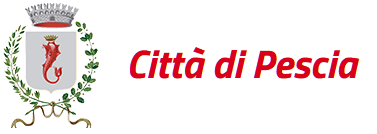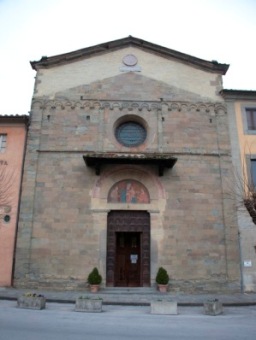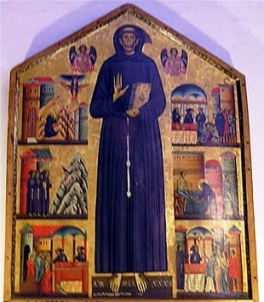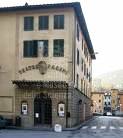
Il Prato di san Francesco


Itinerario :
2 hr-walk
Porta del Giocatoio - Antica via delle Conce - L'ospedale Antonita - Gli orti -Chiesa di S. Antonio abate - Chiesa di S. Rocco - Convento e Chiesa di S.Francesco - Teatro Pacini - Antica filanda dei Cappelletti - Ponte di S.Francesco.
This is an amazing stroll for visitors, our tour will take you to the discovery of plenty of artworks, holy places and century-old traditions. You really need nothing except comfortable trainers, your camera and a bottel of water in the summer. Enjoy!
Once through the gate Porta del Giocatoio, you are in the Rione di S. Francesco. This area, formerly called Prato, literally meadow, as it was beyond the town-walls, was nonetheless of key importance to the town. The contrada extends on the river's left bank whose key features just a couple of years ago were its lovely kitchen gardens. This road used to be known among the inhabitans for its exceptionally skilled craftsmen producing ropes, locally named ´funaiª.
Go past the Porta, to via Cesare Battisti. On your right is the street called del Giocatoio, leading to a breathtakingly panoramic road to the Uzzano hills which in ancient times the leather tanning factories flourished. Walk to the farthest end of via del Giocatoio, go over the tiny bridge, there is the recently restored
picturesquec 18th-century chapel dedicated to the ìMadonna del Giglioî, literally the Virgin Mary of the Lily. A quick look inside to admire the picture of the Virgin Mary in bas-relief of the middle of the 18th-century.
Behind the recent residential complex, you can spot the ancient walls and the imposing ´Torre del Seminarioª or Torre di Santa Chiara, which bordered the convent. Perhaps worth knowing is the fact that this majestic structure was one of the most meaningful within the walls and is always portrayed in the town's iconography.
Use your energies to walk up the steep via del Giocatoio; if you enter via Cesare Battisti, on your right, a few strides from the wall gate, youíll find a memorial tablet as witness of the former importance of this street. In ancient times, in fact, it was the only way northwards, from here you could reach the mountains and besides, it was the gathering-point for business transactions between people coming from the mountains and those coming from the valley.
Keep strolling northwards past the big clothes' shop and the modern Saints Cosmas and Damiano city hospital to the 14th-century St. Anthony Abbot oratory.
The tiny church with its bare facade is mentioned already in 1327, nonetheless some of its parts make us suppose it is even older. Donít skip it, go inside.
This is really worth In the apse chapel admire the frescoes dated 1407 by Bicci di Lorenzo (1373-1452), painter and sculptor active in Florence, whose
04_S. Francesco ing 20-11-2008 12:15 Pagina 9 main theme is the Saint Anthony Abbot's ascetic life.
On the northern wall a highlight is the original picture of 15th-century Pescia. Look closer, the town is so skillfully and realistically depicted in the suggestive fresco The Temptation of Saint Anthony Abbot that you can spot its two urban poles, the river in-between with its two bridges St. Mary's and St.Francis's. Another must-see is in the left chapel, that is, the wooden Deposition dating from the 13th century.
This church is renowned for belonging to the Canons Regular of St. Anthony of Vienne, also Antonines, a Roman Catholic congregation founded in 1095 or so, with the purpose of caring for those suffering from the common medieval disease of St. Anthony's fire. In fact, opposite you can see an interesting stonestructure, formerly an hospital. On your right next to the church, is the huge structure which until 17th-century housed the lay brothers Antonines.
A grande at the facade, in fact, will show the magnificent rectangular armorial bearings of Tau, the greek letter in blue that the members of the community wore on their black habit.
On your left, 20 metres away from the church, stands the Ospedale leopoldino built in 1764 and later turned into an hospital for the will of the Grand Duchy Leopold. Admire the beautiful stone-windows and the elegance of the building with the remarkable coat of arms of the Grand Duchy of Hapsburg-Lorraine right in the middle.
Reach the farthest end of via Cesare Battisti and enter the large piazza S. Francesco, St. Francis Square, the sole remnant of the ancient ´pratoª. Tthis is indeed one of the greenest and most fascinating areas in town. If you feel tired, this is the place to relax and treat yourself to a drink. East is the huge monastery- today the law-court- and the Chiesa di S. Francesco. Plenty of curious legends and stories tell narrate of it, indeed this marvellously monumental church is one of the most beloved by Pesciatins. Here the representatives of the Guelph comuni of Valdinievole met in 1328 to set up a league with an indipendent political identity from Lucca. This agreement set the stage for the occupation by Florence in 1339.
Recently restored in the late 20th-century, the present church dates back to the end of the 14th-century; yet, chroniclers and manuscripts reveal its presence already in the first half of 14th-century. A nice legend tells that when Saint Francis visted Pescia and its community in 1211, he was guest of the Orlandis who built an oratory in his honours. Despite lack of written evidence, the Pesciatin community's devotion to the Italian patron Saint is widespread. A visit inside is worthwhile for a wealth of notable artworks. Admire the Latin cross plant and the transept with two stone altarpiece and splendid paintings at
either side. Each altar and chapel tell of stories and legends of the town. But a real major set-piece is the picture of St. Francis of Assisi on the predella (base of the altarpiece), painted in 1235 by Bonaventura Berlinghieri showing with poignant and detailed scenes six episodes of the life of St. Francis, and his afterdeath miracles. In the same chapel the beautiful sculpture of the Virgin Mary with Child dating back to 14th century. Perhaps noteworthy is the fact that in April 1506 chroniclers report this statue seemed to give miracolous signs to the people preaching. Before leave, make sure you do not miss, at either side of the
altarpiece, on your right the chapel of S. Carlo Borromeo with the remarkable painting by Rodomonte di Pasquino Pieri.Walk up to the apse to the 17th-century painting Miracle of the Mule (1632) by Giovanni Martinelli showing the mule kneeling before the Sacramental bread in Saint Anthony of Padua's hand.
A glance up to admire the late 14th-century frescoes by Antonio Vite which decorate the upper part of the apse chapel. The Nucci chapel is beautifully adorned with frescoes dated of the first half of the 15th century by Bicci di Lorenzo.
Facing the chiesa is the theatre dedicated to the memory of Giovanni Pacini. This glorious theatrical architecture of ´Accademia degli Affilatiª (1717) was built under the protection of Ferdinand de' Medici's wife, the Grand Grand Duchess of Tuscany Violante Beatrice of Bayern, and stands as witness of the Pesciatins' century-old interest for drama, music and theatrical performances.
Once out of the theatre, itís time for a pleasurable stroll along Via della Torre where, on your right, youíll see a massive 16th-century structure - the renowned silk mill ´Galeffi alla Torreª- where silkworm breeding, cocoon silk processing and spinning were carried out. You are in front of the only witness of the lucrative 15th-16th-century silkworm breeding business in Pescia. At the Ponte di San Francesco our cultural stroll comes to an end.

- teatro Pacini

